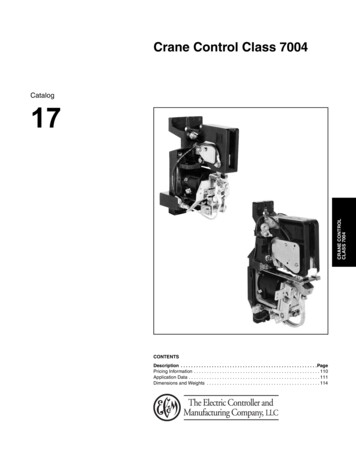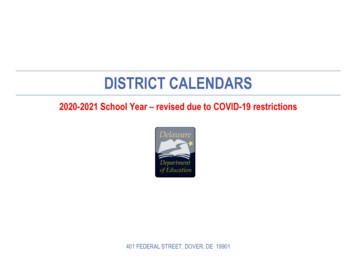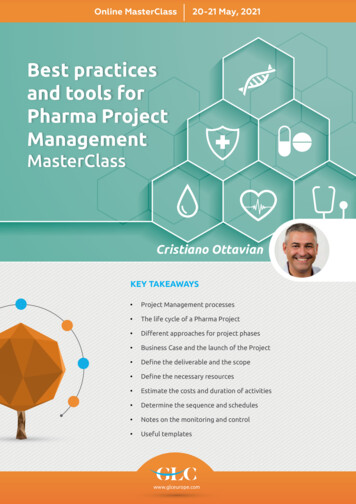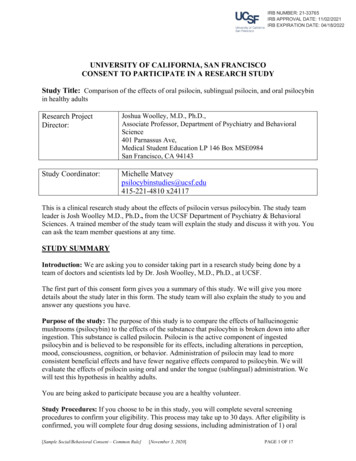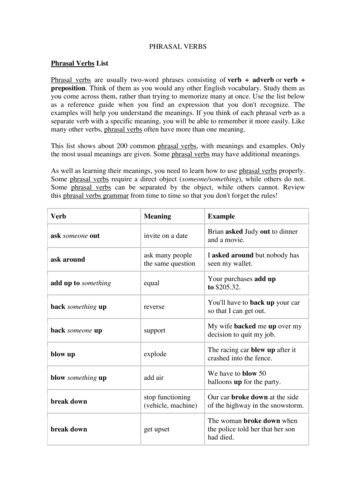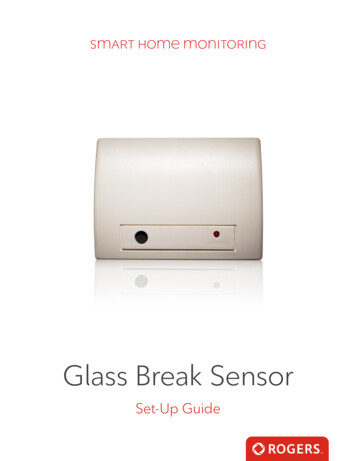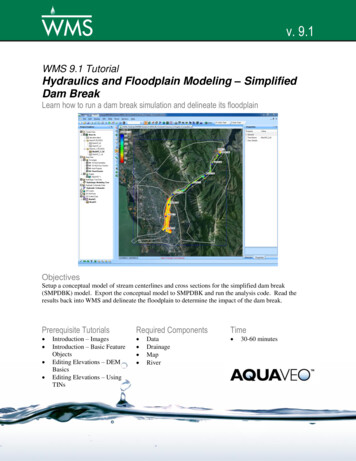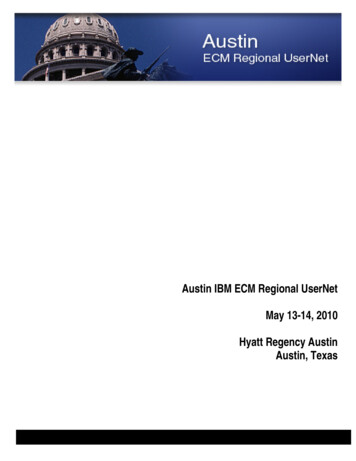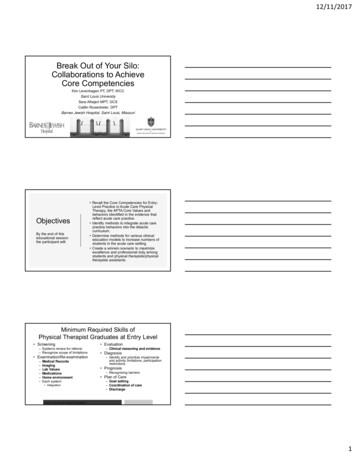
Transcription
12/11/2017Break Out of Your Silo:Collaborations to AchieveCore CompetenciesKim Levenhagen PT, DPT, WCCSaint Louis UniversitySara Alhajeri MPT, GCSCaitlin Rosentreter, DPTBarnes Jewish Hospital, Saint Louis, MissouriObjectivesBy the end of thiseducational sessionthe participant will: Recall the Core Competencies for EntryLevel Practice in Acute Care PhysicalTherapy, the APTA Core Values andbehaviors identified in the evidence thatreflect acute care practice. Identify methods to integrate acute carepractice behaviors into the didacticcurriculum. Determine methods for various clinicaleducation models to increase numbers ofstudents in the acute care setting. Create a win/win scenario to maximizeexcellence and professional duty amongstudents and physical therapists/physicaltherapists assistants.Minimum Required Skills ofPhysical Therapist Graduates at Entry Level Screening– Systems review for referral– Recognize scope of limitations l RecordsImagingLab ValuesMedicationsHome environmentEach system Integration Evaluation– Clinical reasoning and evidence Diagnosis– Identify and prioritize impairmentsand activity limitations, participationrestrictions Prognosis– Recognizing barriers Plan of Care– Goal setting– Coordination of care– DischargeDOISY COLLEGE OF HEALTH SCIENCES1
12/11/2017Minimum Required Skills ofPhysical Therapist Graduates at Entry Level Interventions––––––Airway clearanceAssistive devicesMovement (gait, functional mobility)SafetyCollaborationCommunication across settings Outcome Assessments Education Practice n and supervisionHIPPA/Patient rights Professionalism Consultation Evidence Based Practice– Patients/families– ColleaguesDOISY COLLEGE OF HEALTH SCIENCESMinimum Required Skills of Physical TherapistAssistant Graduates at Entry Level Plan of Care Review‒ Review of physical therapydocuments‒ Identification of role in patient care‒ Identification of items to becommunicated to the physicaltherapist‒ Identify when the directedintervention are either beyondthe scope of work or personalscope of work of the PTA Provision of ProceduralInterventions Patient Instruction‒‒‒‒Application of principles of learningUse of variety of teaching strategiesClarity in instructionsAssessment of patient response Patient Progression‒ Competent patient progression‒ Communication of patientinformation‒ Clinical problem solvingDOISY COLLEGE OF HEALTH SCIENCESMinimum Required Skills of Physical TherapistAssistant Graduates at Entry Level Data Collection––––––Competent date collectionInterview skillsAccurate and timelyClinical problem solvingAbility to modify techniquesDocumentation and communication Documentation– Select relevant information– Accuracy– Ability to adapt Safety, CPR and EmergencyProcedures Reads and understands thehealthcare literature Educate colleagues and otherhealth care professional aboutthe role, responsibilities andacademic preparation andscope of work of the PTA Ensure ongoingcommunication with thephysical therapist for optimalpatient care.DOISY COLLEGE OF HEALTH SCIENCES2
12/11/2017A Normative Model of Physical TherapistProfessional Education: Version 2004“Consistently define and describe entry-level physicaltherapist professional education that is reflective of acontemporary and forward looking perspective of practice,is responsive to physical therapy practice and the healthcare environment, and that incorporates the elements forthe profession's vision.”– Guide to Physical Therapist Practice– Core competencies for area of practice– Movement SystemDOISY COLLEGE OF HEALTH SCIENCESCore Competencies for Entry Level Practicein Acute Care Physical Therapy (2015) Clinical decision makingCommunicationSafetyPatient managementDischarge planningKristin Greenwood, PT, DPT, EdD,MS, GCS ChairEric Stewart, PT, DPTErin Milton, PT, DPT, NCSMelissa Hake, PT, DScPTLauren Mitchell, PT, DPTBabette Sanders, PT, DPT, MS,FAPTA3
12/11/2017Core Competencies for Entry Level Practice forPhysical Therapist Assistants inAcute Care Settings (2017) Communication Safety Patient Management‒ Medical review and documentation Contributions to discharge recommendationsJeremy Foster, LPTA ChairAmanda Rausch, PTAMichele Biernacki, PTA, ACCEChristina Schiel, PT, DPTHolly Clynch, PT, DPT, MA, GCSDeanna Smith, PTChrissy LaMastus, MPT, BSN, RNMovement System (APTA 2017) PTs provide a unique perspective onpurposeful, precise, and efficientmovement across the lifespan basedupon the synthesis of their distinctiveknowledge of the movement system andexpertise in mobility and locomotion. PTs examine and evaluate themovement system (including diagnosisand prognosis) to provide a customizedand integrated plan of care to achievethe individual's goal-directed outcomes. PTs maximize an individual's ability toengage with and respond to his or herenvironment using movement-relatedinterventions to optimize functionalcapacity and performance.DOISY COLLEGE OF HEALTH SCIENCESWhat do the students say? What I learned in the classroom is not real life– Line management– Ventilators Complex patients on paper not the same as the hospital– Clinical reasoning is not always black/white– Difficult to apply classroom knowledge to patients in the clinic Some clinicals too short Not enough acute care choices– May not have a rotation in level 1 trauma center Some time since my acute care rotation and starting my jobDOISY COLLEGE OF HEALTH SCIENCES4
12/11/2017Student Feedback Regarding Preparedness I did not feel under‐prepared for this experience in the sense that wehad not learned certain material yet. However, I did have to look a fewthings up that we had already learned just for a quick refresher! Finding different motivation techniques to encourage patients toparticipate in therapy when they refuse. One suggestion would be to team up with the OT program for a lab andco‐treat a patient so students can learn how to work together efficiently,while also playing a balancing act seeing how both therapies overlap yetdo not cross boundaries. I felt unprepared for ventilator management, IV/leads management,walking patients with multiple medical devices (IV poles, etc.),pharmacology and its implications for PT, discharge disposition.DOISY COLLEGE OF HEALTH SCIENCESReviewing the Evidence(Baybar 2003) Case studypresentation Group discussion Patients in class Patients in clinic Problem solvingvideotapeReviewing the EvidenceJette 2007Masley 2011 Continual Dynamic Assessment ComplexKnowledgeClinical skillsSafetyClinical decision makingSelf directed learningInterpersonal communicationProfessional demeanor– Communication to gain information– Collection and analysis of medicalinformation– Communication to provideinformation– Application of specialized physicaltherapy knowledgeDOISY COLLEGE OF HEALTH SCIENCES5
12/11/2017Foundational SciencesClinical diagnostic proceduresNationwide AcuteCare PhysicalTherapist PracticeAnalysis IdentifiesKnowledge, Skillsand Behaviorsthat Reflect AcuteCare Practice(Gorman 2010)LeadershipRisk managementProfessional developmentSocial nosisInterventionOutcomesBridging the Gap Weaving inpatient care into the curriculum– Pathology clinical examples– Basic Procedure– Multisystem Management Labs Integrative clinical experiences SeminarsDOISY COLLEGE OF HEALTH SCIENCESAcute Care Threaded ThroughoutCurriculumPY 2PY 1Survey of Disease,Lab Studies/Imaging, BasicProcedures,Pharmacology Integrative Project Patients in lab Assist , PatientManagement,Communication Patients in labICEIntegrative ProjectSim LabCollaboration withnursingPY 3Seminars, essionalTeam Seminar,Clinicals Complex evaluationin clinic Cases w/ IPtherapists Collaboration w/PTA Program Interprofessionalinteractions6
12/11/2017Project: Surveyof Disease,Pharmacologyand LabStudies/ImagingExample of Lab: Integrative Clinical Experience Chart Review Subjective Interview Objective Examination–––––––CognitionGross muscle screenDermatome/Light touchVital signsBalance (sitting/standing)Outcome measuresMovement assessment (bed mobility, sit to stand to sit, ambulation)DOISY COLLEGE OF HEALTH SCIENCESExample of Lab: Integrative Clinical Experience Assessment Identify impairments and activity limitation and participationrestrictions. State why patient requires skilled physical therapy. Describe intervention or education provided during this treatmentsession. Plan Determine frequency for therapy sessions during hospital stay. Document 3 short term goals for the patient (met by discharge). Establish a discharge plan.DOISY COLLEGE OF HEALTH SCIENCES7
12/11/2017Example of Lab Integrative Clinical ExperienceDiscuss 3 relevant findings from the chart review with anticipatedpresentation (signs and symptoms and implications with examination.At least one must include an abnormal lab value.Given the patient’s findings today,name 2 interventions and 2 follow‐up examinations you want toperform on the next visit.Explain yourclinical reasoningfor your dischargerecommendation.Include clinical implications for 3pharmacological agents the patient iscurrently taking in the hospital.Discuss how CIadapted theexaminationsecondary tocurrent and pastmedical history.CollaborativeLearning inNursing SimLab“This was a good learning experience for me because I now knowthat I need to make my SBAR statement more clear and concise inAn interprofessional experiencethe future. I especially want to improve upon my "assessmentthrough structured communicationportion" of the SBAR in establishing why the patient might betools such as SBAR provide contextexperiencing various symptoms.”for application in an acute care“It was good to have nursing there and interact with them as well but Ienvironment.found it difficult to cut off my interview and quickly gather my thoughtsto give the SBAR to the nurse in front of the patient.”A HFHS patient scenario withemerging data provided a safeenvironment for learning.“Overall, I liked to experience and I have a better idea of what kindsof communication skills and inpatient skills I can improve upon in thefuture. The experience was unique and not one that we usually get toreceive in school so I really liked to opportunity to see my strengthsand weaknesses in that situation.”“This was a great experience. It was very helpful to be able tocollaborate with the nurse following the interview. It was a good wayto get out first time jitters with experiences like this. I was preparedwith a lot of questions to complete a full interview but due to thesignificant changes in BP and heart rate and presents of redness,swelling, and tenderness in her L calf I had to stop short.”DOISY COLLEGE OF HEALTH SCIENCES8
12/11/2017WHAT IS YOUR PRIMARYCLINICAL EDUCATIONCHALLENGE?Capacity vs QualityCapacity or QualityOUR SSING QUALITY:FROM THE CLINICAL SITEPERSPECTIVEORIENTATION & COMMUNICATION9
12/11/2017HOW DO WE MANAGEALL OF THIS ORIENTATION?IT TAKES A VILLAGE32Structuresimilar toemployeeorientationComponentsof Our StudentOrientationProgram10
12/11/2017EXAMPLES OF ASSIGNED STUDENT PROJECTSBring Evidence To StaffCase Studies and Journal ClubsAnalyze Evidence for OutcomesMeasuresCreate/Update Patient HandoutsUpdate Existing DocumentsWith Current NormsCreate Videos - For StudentOrientation,Transfer Training, etcUpdate Student OrientationMaterialsArchive Students’ ProjectsFor Future UseFEEDBACK FROM SLU STUDENTS The student program at Barnes (Jewish Hospital) is great! They are veryopen to teaching you as much as possible and exposing you to the waythe hospital system operates. Doing the case study/inservice was helpful to learn more about inpatientPT and different interventions to provide. All of the training and orientation was very helpful for succeeding on thisclinical. I thought the student program was structured very well. I learned somuch on this rotation and was able to get a great understanding of whatPT's role is in acute care.35ADDRESSING QUALITY:FROM THEACADEMIC PERSPECTIVE3611
12/11/2017ADDRESSING CAPACITY:FROM THEACADEMIC PERSPECTIVEADDRESSING CAPACITYFROM THECLINICAL SITE PERSPECTIVESCCE COMMUNICATIONWITH CLINICAL INSTRUCTORS12
CAL EDUCATION MODELS1 Student:1 Instructor1 Student:2 Instructors2 Students:1 Instructor13
12/11/2017CLINICAL EDUCATION MODELS1 Student:1 InstructorPT or PTAStudentICECLINICAL EDUCATION MODELS1 Student:2 InstructorsFull TimeStudent SharedBetween 2 PartTime TherapistsSplit ClinicalBetween 2 FullTime TherapistsCLINICAL EDUCATION MODELS2 Students:1 Instructor2 PT/PTAStudentsPT Student/PTA StudentStudentLabsPT Student/Student LabsPT Student/ICE Student14
12/11/2017POLICIES AND REGULATIONS:STUDENT SUPERVISION2:1 CLINICAL MODELBarriersStudentQuality ofClinicalTreat TogetherInstructorComparison toStudentToo Much TimeDivided CIAttentionStudents atDifferent LevelsDecreaseProductivity atBeginningIncreasedStressGeneralizedFeedback2 CPI!!2xDocumentationReview2:1 CLINICAL nowledgeInstructorSecurityFosterIndependenceGet ComfortablewithUncomfortableLifelong LearnerExperienceIncreasedProductivityLess StressLarger CaseloadExpert15
12/11/2017IncreasedCollaborationDirection andSupervisionEducationPT STUDENT & PTA STUDENT:INSTRUCTOR MODELPTStudentPTAStudentScope OR ROLE MODELSpecialty Sections and Special Interest Groups(Education Section of APTA)Education Leadership ConferenceAmerican Council of Academic Physical Therapy(ACAPT)Literature Review/EBPOnline Links: Balance Testing, Stroke Education, ECGKnowledge, etcRESOURCESTO EXPLOREAPTA Learning CenterAcuTEACH Forum in AACPT16
12/11/2017BREAK DOWN THE SILO: IMPROVING CAPACITY AND QUALITYAcademic WinsClinic WinsIncreasing student placementsTeaching opportunities for staffAdvancing current practice: Awareness ofcurrent trends in clinical practiceAdvancing current practice: In-service on topicsrelevant to your practice (Student or faculty)Building relationships with facilities/sites(Recruiting lab assistants/adjunct faculty)Building relationships with academic institutions(Opportunities: lab assistant, email list for CEUs)Preparing students for entry levelpractice/Normative ModelIncreasing efficiency of new hire for orientationand productivity when previously a student atthat siteImproving application of curriculum content Completing projects: Students can do these toobecause of hands on experienceRefining students inter-professionalcommunicationImproving employee retention (Educateddecision when applying for position)DOISY COLLEGE OF HEALTH SCIENCESREFERENCES APTA A Normative Model of Physical Therapist Professional Education: 2004. Guide to Physical Therapist Practice 3.0. Alexandria, VA: American Physical TherapyAssociation; 2014. Available at: http://guidetoptpractice.apta.org/. Accessed 11/1/17. APTA Professionalism in Physical Therapy: Core Values BOD P05-04-02-03[AM E N D E D BOD 08-03-04- 10]http://www.apta.org/uploadedFiles/APTAorg/About Us/Policies/Judicial Legal/ProfessionalismCoreValues.pdf Accessed on 3/6/2017. Core Competencies for Entry-Level Practice in Acute Care Physical Therapy. APTAAcademy of Acute Care Physical Therapy Minimum Skills Task Force; 2015. Gorman SL, Wruble Hakim E, Johnson W, et al. Nationwide acute care physicaltherapist practice analysis identifies knowledge, skills, and behaviors that reflectacute care practice. Phys Ther. 2010; 90 (10): 1453-1467. Doi: 10.2522/ptj.20090385 Masley PM, Havrilko CL, Mahnensmith MR, et al. Physical therapist practice in theacute care seting: A qualitative study. Phys Ther. 2011; 91(6), 906-922. Doi:10.2522/ptj.20100296. Delany C, Bragge P. A study of physiotherapy students' and clinical educators'perceptions of learning and teaching. Med Teach. 2009 Sep;31(9):e402-11.DOISY COLLEGE OF HEALTH SCIENCESREFERENCESDunfee HJ. Clinical Education: Past, Present, and Future. Journal of Physical Therapy Education.2008;22(3):3‐6. Plack Margaret M. The Learning Triad: Potential Barriers and Supports to Learning in thePhysical Therapy Clinical Environment. J of Physical Therapy Education. 2008;22(3):7‐18. Rosenwax L, Gribble, N, Margaria, H. GRACE: An Innovative Program of Clinical Education inAllied Health. Journal of Allied Health. 2010;39(1):e11‐e16. Giberson Tomas R, Black Beth, Pinkerton, Eric. The Impact of Student‐Clinical Instructor Fit andStudent‐Organization Fit on Physical Therapist Clinical Education: Experience Outcome. Journalof Physical Therapy Education. 2008;22(1):59‐64. Smith PM, Seeley J. A review of the evidence for the maximization of clinical placementopportunities through interprofessional collaboration. J Interprof Care. 2010 Nov;24(6):690‐8. Jette D, Brown R, Collette N, Friant W, Graves L. Physical Therapists’ Management of Patients inthe Acute Care Setting: An Observational Study. Phys Ther. 2009;89(11):1158‐1181. APTA student supervision chart Accessed 11/27/17. DOISY COLLEGE OF HEALTH SCIENCES17
12/11/2017REFERENCES Jette D, Bertoni A, Coots R, Johnson H, McLaughlin C, Weisbach. ClinicalInstructors’ Perceptions of Behaviors That Comprise Entry Level ClinicalPerformance in Physical Therapist Students: A Qualitative Study. Phys Ther.2007; 87:833-843. Silberman N, Panzarella K, Melzer B. Using Human Simulation to PreparePhysical Therapy Students for Acute Care Clinical Practice. Journal of AlliedHealth. 2013; 42(1): 25-32. Pabian P, Dyson J, Levine C. Physical Therapist Productivity Using aCollaborative Clinical Education Model Within an Acute Care Setting: ALongitudinal Study. Journal of Physical Therapy Education. 2017;31(2): 11-17. Ohtake PJ, Lazarus M, Schillo R, Rosen M. Simulation experience enhancesphysical therapist student confidence in managing a patient in the critical careenvironment. Phys Ther. 2013;93:216-228.DOISY COLLEGE OF HEALTH SCIENCESREFERENCES McCallum CA, Mosher PD, Jacobson PJ, Gallivan SP, Giuffre SM. Quality inphysical therapist clinical education: A systematic review. Physical Therapy.2013;93(10):1-18. Ladychewsky RK, Bird N, Finney J. The impact on departmental productivityduring physical therapy student placements: An investigation of outpatient physicaltherapy services. Physiotherapy Canada. 1994;46(89-93). Currens JB, Bithell CP. The 2:1 clinical placement model- Perceptions of clinicaleducators Innovative Clinical Internship Model in the US Army-Baylor DoctoralProgram in Physical Therapy. US Army Medical Department Journal. 2014:30-34. Jelley W, Larocque N, Patterson S. Interdisciplinary clinical education forphysiotherapists and physiotherapist assistants.: a pilot study. PhysiotherapyCanada. 2010;62(1):75-80. Triggs-Nemshick M, Shepard KF. Physical therapy clinical education in a 2:1student instructor education model. Physical Therapy. 1996;76(9):968-981. O’Connor A, Cahill M, McKay E. Revisiting 1:1 and 2:1 clinical placement models:student and clinical educator perspectives. Aust Occup Ther J. 2012;59(4):276283.DOISY COLLEGE OF HEALTH SCIENCES18
DOISY COLLEGE OF HEALTH SCIENCES An interprofessional experience through structured communication tools such as SBAR provide context for application in an acute care environment. "This was a good learning experience for me because I now know that I need to make my SBAR statement more clear and concise in
